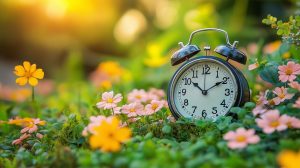It may be tempting to believe that humanity, with its sophisticated lighting, has outgrown the natural influence of sunlight on its sleeping habits. However, new research from the University of Michigan shows that our circadian rhythm is still fundamentally untamable and follows the seasonal changes in daylight.
Circadian Rhythms and Seasonal Changes
“Humans are truly seasonal creatures, even if we may not want to admit it in our modern world,” says study author Ruby Kim, a postdoctoral researcher and assistant professor of mathematics at U-M. “The length of the day and the amount of sunlight we get have a powerful influence on our physiology. The study shows that our biologically determined seasonal rhythm influences how we adapt to changes in our daily routine.” This finding could open up new avenues for researching and understanding seasonal affective disorder, a form of depression linked to seasonal changes. It could also open up new areas of research in a range of other health areas related to the alignment of our sleep habits and our internal clock.
For example, researchers—including the study’s lead author, Daniel Forger, a professor of mathematics at U-M and director of the Michigan Center for Applied and Interdisciplinary Mathematics—have previously shown that our mood is strongly influenced by how well our sleep habits align with our circadian rhythm. “This work is very promising for future insights,” Kim said of the new study, published in the journal npj Digital Medicine. “This could have profound implications for mental health issues such as mood swings and anxiety, but also for metabolic and cardiovascular diseases.” The research also showed that there is a genetic component to this seasonality in humans, which could help explain the large differences in the severity with which people are affected by changes in day length. Some people are better at adapting than others. Exploring this genetic component will help researchers and doctors understand where individuals fall on this spectrum, but much time and effort will be required before that happens. For now, this study is a first but important step that redefines our understanding of human circadian rhythms.
“Many people tend to think of their circadian rhythms as a single clock,” Forger said. “We show that there isn’t really one clock, but two. One tries to track dawn, the other tries to track dusk, and they communicate with each other.” Kim, Forger, and their colleagues used sleep data from thousands of people who used wearable health devices such as Fitbits to find that people’s circadian rhythms are aligned with the seasons. The participants were all resident physicians completing a one-year internship and participating in the Intern Health Study funded by the National Institutes of Health. Interns are shift workers whose schedules change frequently, which means their sleep patterns also change. In addition, these work schedules often conflict with the natural day-night rhythm. The fact that circadian rhythms in this population group show a seasonal dependence is a compelling argument for how firmly this trait is anchored in humans, which is not entirely surprising, according to the researchers.
Genetic Component
There is ample evidence from studies with fruit flies and rodents that animals have seasonal circadian clocks, according to Forger, and other researchers have suggested that human circadian clocks may function similarly. Now, by observing this seasonality in a large-scale study under real-world conditions, the U-M team has provided some of the most compelling evidence yet for this hypothesis. “I actually find it very plausible. The physiology of the brain has been trying to track twilight for millions of years,” Forger said. “Then industrialization came along, which from an evolutionary perspective was just the blink of an eye, and now we’re still trying to catch up.” Participants in the Intern Health Study also provided saliva samples for DNA testing, allowing Kim and Forger’s team to incorporate a genetic component into their study.
Genetic studies by other researchers have identified a specific gene that plays an important role in how animals’ circadian clocks track seasonal changes. Humans also have this gene, so the U-M team was able to identify a small percentage of interns with minor variations in the genetic makeup of this gene. In this group of people, shift work had a greater impact on the adjustment of their circadian clocks and sleep habits throughout the seasons. This also raises many questions, particularly regarding the health effects and impact of shift work on different individuals. However, the researchers plan to investigate these questions in the future.








